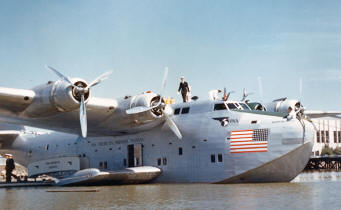
| NEWSROOM |
|
|
 |
|
|
|
|
|
|||
|
By Mike Mitchell |
||||
 |
February 3, 2010 -
A panel of
The panelists will
discuss the history, design and operations of Pan Am's flying boats,
with a focus on the icon of the age--the Boeing 314 Clipper. The program
will be illustrated with dozens of rare photographs from The Museum of
Flight Photo Archive. Engineer Robert Blake started working for Pan
American Airlines in |
|||
|
Pan Am Boeing 314 Clipper. Courtesy The |
||||
|
Pan American World Airways, commonly known as Pan Am, was the "flagship"
international airline of the
A question and answer session follows the program and the panelists will
be available for signing Pan Am memorabilia. The presentation is at 2
p.m. in the
The Boeing 314 Clipper, responding to a request by Pan American Airlines
for a large airliner capable of flying across oceans in the mid-1930s,
Boeing--with a late entry to the design competition--developed the huge,
luxurious Model 314 flying boat. It joined the Pan Am "Clipper" fleet in
1939. With its two-deck cabin, it became the "jumbo" airplane of it's
the era. |
||||
|
With a range of
3,500 miles, the first scheduled trans-Atlantic Clipper flight was June
28, 1939. By 1940 the 314s were routinely flying across the Pacific.
Clipper passengers enjoyed large windows, dressing rooms and gourmet
meals served in a dining salon. The flying boat could seat up to 74
passengers, or in an overnight "sleeper" configuration with 40 bunks. A
dozen Model 314s were built by the end of 1941. With World War II,
Clippers were used as military transports. There are no surviving
examples of the plane today.
The
Over 30 aircraft
representing the first century of aviation are displayed in the
all-glass T.A. Wilson Great Gallery. The evolution of space flight and a
look into the future are presented in the exhibit, Space: Exploring the
New Frontier. The Airpark includes outdoor displays including the first
jet Air Force One, a supersonic Concorde airliner and the prototype
Boeing 747 jumbo jet. Interactive displays in The Flight Zone provide
educational and entertaining activities for young children.
The Museum's
aeronautical library and archival holdings are the largest on the West
Coast. More than 140,000 students are served annually by the Museum's
on-site and outreach educational programs--the most extensive
museum-based youth aviation and space education program in the country.
The Museum is the only air and space museum in
The |
| ?AvStop
Online Magazine
Contact
Us
Return To News
|
|